The Adventures of Tintin (film)
7.6 /10 1 Votes7.6
75% Rotten Tomatoes 68% Metacritic Genre Animation, Action, Adventure Duration Language English | 7.4/10 IMDb 3.5/4 Roger Ebert Budget 135 million USD Country United StatesNew Zealand | |||||||||||||||||||||||||||||||||
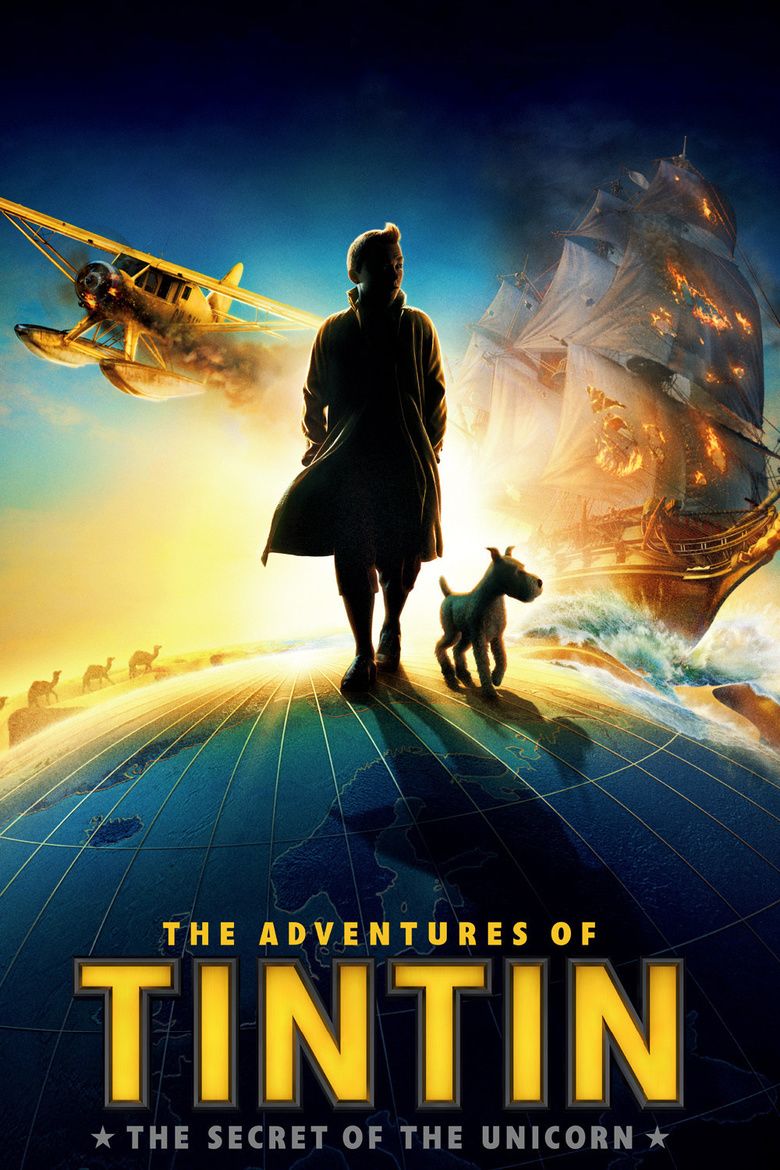 | ||||||||||||||||||||||||||||||||||
Release date Writer Steven Moffat (screenplay), Edgar Wright (screenplay), Joe Cornish (screenplay), Herge (comic book series "The Adventures of Tintin") Cast (Sakharine / Red Rackham (voice)), (Inspector Thompson (voice)), (Pilot (voice)), (Tintin (voice)), (Captain Haddock / Sir Francis Haddock (voice)), (Thomson (voice)) Similar movies Tagline This year, discover how far adventure will take you. | ||||||||||||||||||||||||||||||||||
The adventures of tintin behind the scenes steven spielberg movie 2011 hd
The Adventures of Tintin, known as The Adventures of Tintin: The Secret of the Unicorn outside North America, is a 2011 3D motion capture computer-animated mystery adventure comedy film based on The Adventures of Tintin, the comics series by Belgian cartoonist Hergé. Directed by Steven Spielberg, produced by Peter Jackson, and written by Steven Moffat, Edgar Wright and Joe Cornish, the film is based on three of Hergé's albums: The Crab with the Golden Claws (1941), The Secret of the Unicorn (1943), and Red Rackham's Treasure (1944). The cast includes Jamie Bell, Andy Serkis, Daniel Craig, Nick Frost and Simon Pegg.
Contents
- The adventures of tintin behind the scenes steven spielberg movie 2011 hd
- The adventures of tintin trailer 2011 peter jackson steven spielberg 3d
- Plot
- Cast
- Development
- Filming and visual effects
- Music
- Differences from the source material
- Video game
- Theatrical release
- Home media
- Critical response
- Box office
- Accolades
- Sequels
- References

Spielberg acquired rights to produce a film based on The Adventures of Tintin series following Hergé's death in 1983, and re-optioned them in 2002. Filming was due to begin in October 2008 for a 2010 release, but release was delayed to 2011 after Universal opted out of producing the film with Paramount, who provided $30 million on pre-production. Sony chose to co-produce the film. The delay resulted in Thomas Sangster, who had been originally cast as Tintin, departing from the project. Producer Peter Jackson, whose company Weta Digital provided the computer animation, intends to direct a sequel. Spielberg and Jackson also hope to co-direct a third film. The world première took place on 22 October 2011 in Brussels. The film was released in the UK and other European countries on 26 October 2011, and in the USA on 21 December 2011, in Digital 3D and IMAX.
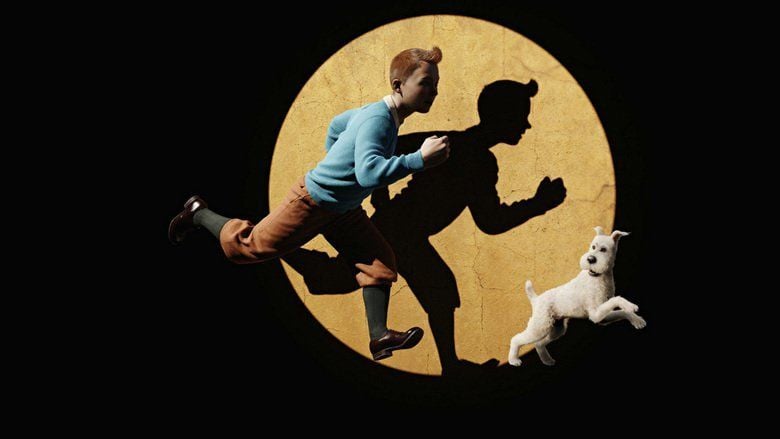
The Adventures of Tintin grossed over $373 million, and received positive reviews from critics, being compared to Spielberg's previous work Raiders of the Lost Ark. It was the first non-Pixar animated film to win the Golden Globe Award for Best Animated Feature Film. Williams was nominated for an Academy Award for Best Original Score. It was nominated for six Saturn Awards, including Best Animated Film, Best Director for Spielberg and Best Music for Williams.
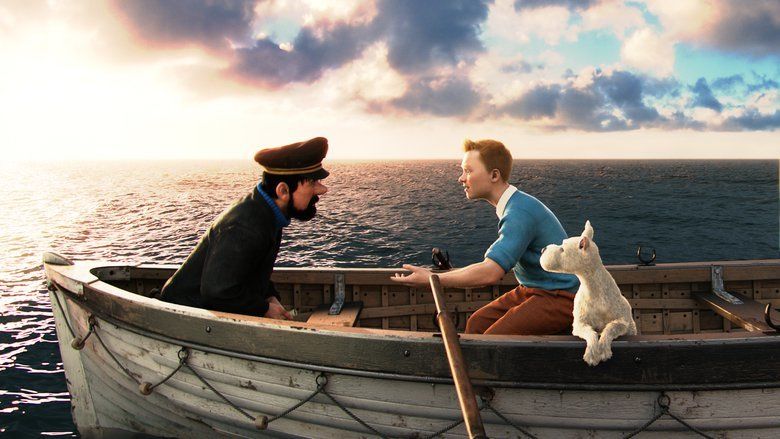
The adventures of tintin trailer 2011 peter jackson steven spielberg 3d
Plot
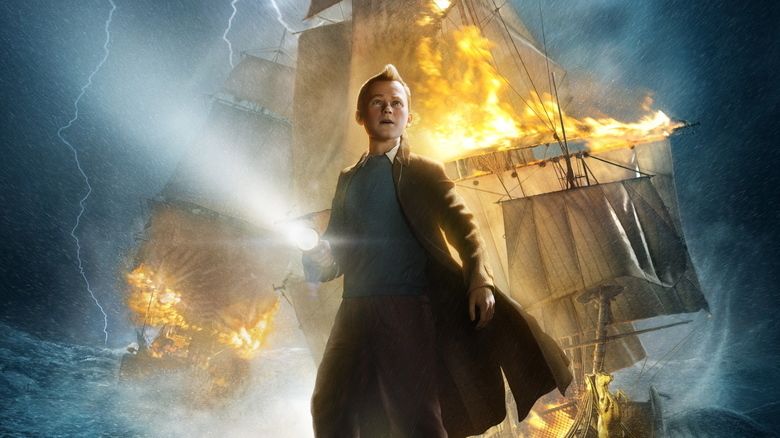
In the 1930s, young journalist Tintin and his dog Snowy are browsing in an outdoor market in Brussels, Belgium. Tintin buys a miniature model of a ship, the Unicorn, but is accosted by an Interpol officer, Barnaby, and a dreaded ship collector, Ivan Ivanovitch Sakharine, who both unsuccessfully tried to make their purchases. Tintin takes the ship home, but it is accidentally broken in an incident between Snowy and a cat in his apartment. A parchment scroll slips out of the ship, and rolls under the furniture, unnoticed by Tintin. Meanwhile, bumbling police detectives Thomson and Thompson are on the trail of a pickpocket, Aristides Silk.

After a visit to Maritime Library to search for answers regarding the Unicorn, Tintin returns to find that the Unicorn has been stolen, suspecting Sakharine. He visits Marlinspike Hall and accuses him of the theft. After arguing, Tintin begins to notice that Sakharine's model is not broken, realizing that there are two Unicorn models. After returning home, which appeared to be ransacked, Snowy shows him the scroll. After reading an old message written on it, they are interrupted by the arrival of Barnaby, who is then assasinatated while attempting to recover the Unicorn. Tintin places the scroll in his wallet, but it is stolen by Silk the next morning, after a scuffle with the police detectives.
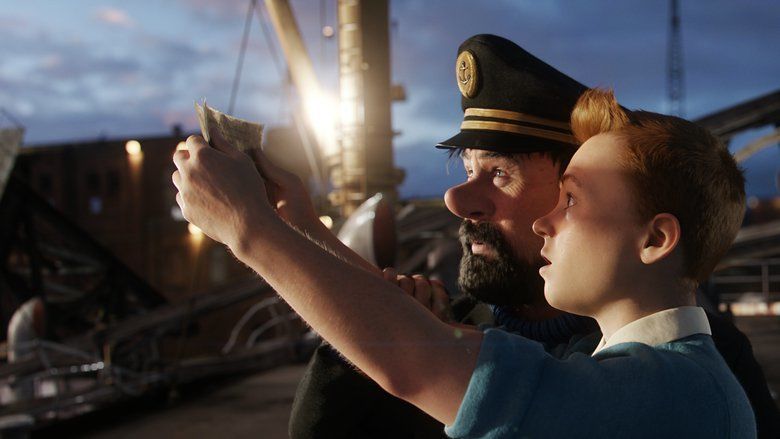
Later, Tintin is abducted by accomplices of Sakharine, and imprisoned on the SS Karaboudjan. He learns that Sakharine formed an alliance with the ship's staff and led a mutiny to take over control. On board, Tintin meets Captain Haddock, the ship's captain. Haddock is permanently drunk and thus unaware of the happenings on board his ship. Tintin, Haddock, and Snowy eventually outrun the crew, and escape from the Karaboudjan in a lifeboat. The ship fails to ram their boat, because they instead rammed an empty lifeboat the captain accidentally released during his escape. Presuming them to have survived by the number of lifeboats, Sakharine sends a seaplane to find and capture them. The trio seize the plane, and use it to fly towards the fictitious Moroccan port of Bagghar. However, the seaplane crashes in the desert due to low fuel.
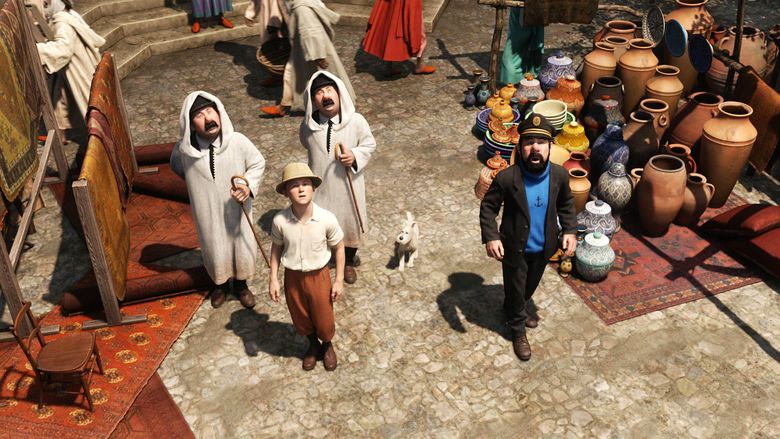
While trekking through the desert, Haddock hallucinates, and remembers facts about an ancestor of his, Sir Francis Haddock, who was a 17th-century captain of the Unicorn. Sir Francis' treasure-laden ship was attacked by the crew of a pirate ship, led by Red Rackham and after his eventual surrender, Sir Francis sank the Unicorn, and most of the treasure, to prevent it from falling into Rackham's hands. It implies that there were three Unicorn models, each containing a scroll; together, the scrolls can reveal coordinates of location of the sunken Unicorn and its treasure.
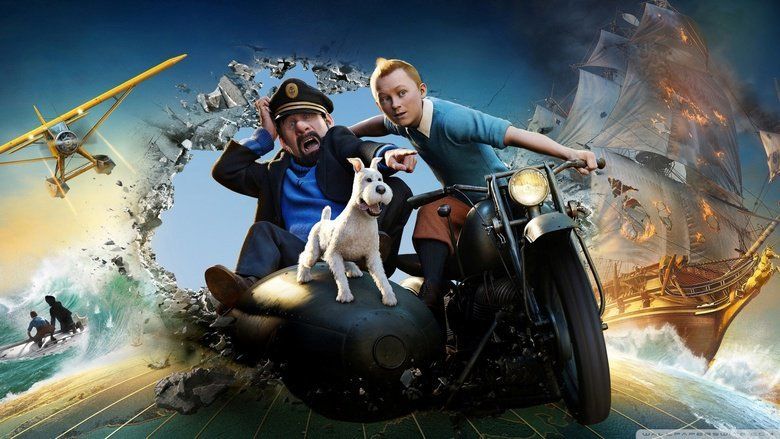
The third model is in Bagghar, possessed by Omar ben Salaad. Sakharine causes a distraction in a Bianca Castafiore concert that results in him successfully stealing the third scroll. After a chase through the city, he gains all the scrolls by having his men toss Captain Haddock and Snowy in the water, to force Tintin to go after them instead of saving the scrolls. After the boat leaves, Tintin is ready to give up, but is persuaded by Haddock to continue. With help from officers Thompson and Thomson, Tintin and Haddock track Sakharine down, who is revealed to be a descendant of Red Rackham. They head back to port and set up a trap, but Sakharine uses his pistol to resist arrest. When his men fail to save him, Sakharine challenges Haddock to a final showdown. Sakharine and Haddock sword-duel with cranes and swords eventually resulting in Sakharine being defeated and pushed overboard by Haddock. When climbing ashore, Sakharine is arrested by Thomson and Thompson.
Guided by the three scrolls indicating the location of Marlinspike Hall, Tintin and Haddock find there some of the treasure and a clue to the Unicorn's location. Both men agree on setting up an expedition to find the shipwreck.
Cast
Development
Spielberg had been an avid fan of The Adventures of Tintin comic books, which he discovered in 1981 when a review compared Raiders of the Lost Ark to Tintin. Meanwhile, the comics' creator, Hergé—who didn't like the previous live-action film versions and the animated series—became a fan of Spielberg. Michael Farr, author of Tintin: The Complete Companion, recalled Hergé "thought Spielberg was the only person who could ever do Tintin justice". Spielberg and his production partner Kathleen Kennedy of Amblin Entertainment were scheduled to meet with Hergé in 1983 while filming Indiana Jones and the Temple of Doom in London. Hergé died that week, but his widow decided to give them the rights. A three-year long option to film the comics was finalized in 1984, with Universal as distributor.
Spielberg commissioned E.T. the Extra-Terrestrial writer Melissa Mathison to script a film where Tintin battles ivory hunters in Africa. Spielberg saw Tintin as "Indiana Jones for kids" and wanted Jack Nicholson to play Haddock. Unsatisfied with the script, Spielberg continued with production on Indiana Jones and the Last Crusade. The rights returned to the Hergé Foundation. Claude Berri and Roman Polanski became interested in filming the property, while Warner Bros. negotiated for the rights, but they could not guarantee the "creative integrity" that the Foundation found in Spielberg. In 2001, Spielberg revealed his interest in depicting Tintin with computer animation. In November 2002, his studio DreamWorks reestablished the option to film the series. Spielberg said he would just produce the film. In 2004, the French magazine Capital reported Spielberg was intending a trilogy based on The Secret of the Unicorn / Red Rackham's Treasure, The Seven Crystal Balls / Prisoners of the Sun and The Blue Lotus / Tintin in Tibet (which are separate stories, but both feature Chang Chong-Chen). By then, Spielberg had reverted to his idea of a live-action adaptation, and called Peter Jackson to ask if Weta Digital would create a computer-generated Snowy.
Jackson, a longtime fan of the comics, had used motion capture in The Lord of the Rings and King Kong. He suggested that a live-action adaptation would not do justice to the comic books and motion capture was the best way of representing Hergé's world of Tintin. A week of filming took place in November 2006 in Playa Vista, Los Angeles, California, on the stage where James Cameron shot Avatar. Andy Serkis had been cast, while Jackson stood in for Tintin. Cameron and Robert Zemeckis were present during the shoot. The footage was transmitted to Weta Digital, who produced a twenty-minute test reel that demonstrated a photorealistic depiction of the characters. Spielberg said he would not mind filming it digitally because he saw it as an animated film, and reiterated his live-action work would always be filmed traditionally. Lead designer Chris Guise visited Brussels to see the inspiration for Hergé's sceneries.
An official announcement about the collaboration was made in May 2007, although both filmmakers had to wait to film it: Spielberg was preparing Indiana Jones and the Kingdom of the Crystal Skull and Jackson was planning The Lovely Bones. Spielberg had considered two books to become the main story, The Crab with the Golden Claws and The Secret of the Unicorn, with the main plot eventually following the latter and its immediate sequel Red Rackham's Treasure. Jackson felt the former's story "wasn't really robust enough to sustain a feature film", but the filmmakers still included elements from the comic such as the Karaboujan and the first meeting of Tintin and Haddock. Spielberg invited Edgar Wright to write the film, but the filmmaker was busy and instead recommended other names, including Steven Moffat. In October 2007, Moffat was announced as having signed on to write the screenplays for two of the Tintin films. Moffat said he was "love bombed" by Spielberg into accepting the offer to write the films, with the director promising to shield him from studio interference with his writing. Moffat finished a draft, but he was unable to do another because of the 2007–2008 Writers Guild of America strike. He then became executive producer of Doctor Who, leading Spielberg and Jackson (both of whom are fans of the show) to allow him to leave and fulfill his duty to the series. Wright agreed to take over the script, and Joe Cornish, a fan of Tintin with whom Wright was working at the time, worked on it with him.
More filming took place in March, 2008. However, in August 2008, a month before principal photography would have begun, Universal turned down their option to co-produce the film, citing the low box office of Monster House and Beowulf, as well as the directors' usual request for 30% of the gross. Paramount Pictures (DreamWorks' distributor) had hoped to partner with Universal on the project, having spent $30 million on pre-production. Spielberg gave a ten-minute presentation of footage, hoping they would approve filming to begin in October. Paramount Pictures, along with their subsidiary Nickelodeon Movies offered to produce as long as the directors found a studio that was willing to co-produce the film: Spielberg and Jackson agreed and negotiated with Sony's Columbia Pictures to co-finance and distribute the first film internationally by the end of October. Sony only agreed to finance two films, though Jackson said a third film may still happen.
Filming and visual effects
Filming began on 26 January 2009, and the release date was moved from 2010 to 2011. Spielberg finished his film—after 32 days of shooting—in March 2009. Jackson was present for the first week of filming and supervised the rest of the shoot via a bespoke videoconferencing program. Simon Pegg said Jackson's voice would "be coming over the Tannoy like God". During filming, various directors including Guillermo del Toro, Stephen Daldry and David Fincher visited. Spielberg would try to treat the film like live-action, moving his camera around. He revealed, "Every movie I made, up until Tintin, I always kept one eye closed when I've been framing a shot," because he wanted to see the movie in 2-D, the way viewers would. "On Tintin, I have both of my eyes open". Jackson took the hands-on approach to directing Weta Digital during post-production, which Spielberg supervised through video conferencing. Jackson will also begin development for the second film, for which he will be officially credited as director. Spielberg says "there will be no cell phones, no TV sets, no modern cars. Just timeless Europe". His cinematographer Janusz Kamiński serves as lighting consultant for Weta, and Jackson said the film will look "film noirish, very atmospheric". Spielberg finished six weeks of additional motion-capture filming in mid-July 2009. Post production was finished on September 2011. From the very beginning to the very end, the film took a total of seven years.
To improve the quality of the indoor lighting nuances, Weta Digital and NVIDIA developed a ray tracing software called PantaRay, which required 100 to 1000 times more computation than traditional shadow-map based solutions. For the performance of "Snowy", various models served as a reference for actors on-set, manipulated by property master Brad Elliott. According to animators, Snowy was also the hardest character to animate and develop, due to the type of coat he has as well as being white. Later, a dog's motion was captured digitally, so the animators had inspiration for realistic movements. His vocal effects were taken from various breeds of dogs.
Music
John Williams composed the musical score for The Adventures of Tintin. It was Williams' first film score since 2008's Indiana Jones and the Kingdom of the Crystal Skull, as well as his first animated film. Most of the score was written while the film's animation was still in the early stages, with Williams attempting to employ "the old Disney technique of doing music first and have the animators trying to follow what the music is doing". Eventually several cues had to be revised when the film was edited. The composer decided to employ various musical styles, with "1920s, 1930s European jazz" for the opening credits, or "pirate music" for the battle at sea. It was released on 21 October 2011 through Sony Classical Records.
The score received very positive reviews from critics.
All music composed by John Williams.
Differences from the source material
The film mainly draws its story from The Secret of the Unicorn (1943) and The Crab with the Golden Claws (1941), and to a much lesser degree, from Red Rackham's Treasure (1944). There are major differences from the source material, most notably with regard to the antagonists. In the book, Ivan Sakharine is a minor character, neither a villain nor the descendant of Red Rackham, and the main villains are instead the Bird brothers, who are absent from the film adaptation (save for a small "cameo" in the initial sequence at the market). As a result, many events transpire that bear no relation to events in the books involving Sakharine's character. As in other adaptations Snowy's "voice" is not used.
Video game
A video game entitled The Adventures of Tintin: The Secret of the Unicorn, developed by game developer Ubisoft, has been released to coincide with the release date of the film. Gameloft released a game for iOS devices to coincide with the film's European launch.
Theatrical release
The film's first press-screening was held in Belgium on 10 October 2011. The world première was held in Brussels, Belgium on 22 October 2011—attended by Princess Astrid and her younger daughters, Princess Luisa Maria and Princess Laetitia Maria; with the Paris première later the same day. Sony later released the film during late October and early November 2011 in Europe, Latin America, and India. The film was released in Quebec on 9 December 2011. Paramount distributed the film in Asia, New Zealand, the U.K., and all other English-speaking territories. They released the film in the United States on 21 December 2011.
Home media
On 13 March 2012, Paramount Home Entertainment released The Adventures of Tintin on DVD and Blu-ray. Both formats of the film were also released in a Blu-ray + DVD + Digital Copy combo pack and a Blu-ray 3D + Blu-ray + DVD + Digital Copy combo pack, with each pack including 11 behind-the-scenes featurettes.
During its first week available on home video, The Adventures of Tintin Blu-ray was the number one selling HD movie after selling 504,000 units and generating $11.09 million in sales. The film was also the second highest selling home media seller during its first week, with 50% of its profits coming from its Blu-ray market.
Critical response
The Adventures of Tintin received positive reviews from critics. Based on 197 reviews collected by review aggregate site Rotten Tomatoes, the film scored a 75% "Certified Fresh" approval rating, with an average rating of 7/10. The site's critical consensus is, "Drawing deep from the classic Raiders of the Lost Ark playbook, Steven Spielberg has crafted another spirited, thrilling adventure in the form of Tintin." Metacritic, another review aggregator which assigns a weighted mean rating out of 100 to reviews from mainstream critics, calculated an average score of 68, based on 40 reviews, which indicates "generally favorable reviews". According to CinemaScore, audiences gave the film a positive "A" grade.
Colin Covert of Star Tribune gave the film 4 out of 4 stars and said that Spielberg's first venture into animation was his most delightful dose of pure entertainment since Raiders of the Lost Ark. Amy Biancolli of the San Francisco Chronicle wrote, "Such are the timeless joys of the books (and now the movie), this sparkling absurdity and knack for buckling swash under the worst of circumstances. The boy may have the world's strangest cowlick, but he sure can roll with the punches."
Roger Ebert, writing for Chicago Sun-Times, labeled the film as "an ambitious and lively caper, miles smarter than your average 3-D family film". He praised the setting of the film, stating its similarity to the original Tintin comic strips, and was also pleased with the 3-D used in the film, saying that Spielberg employed it as an enhancement to 2-D instead of an attention-grabbing gimmick. He gave it 3.5 out of 4 stars.
Peter Travers of Rolling Stone gave the film 3.5 out of 4 stars and wrote, "The movie comes at you in a whoosh, like a volcano of creative ideas in full eruption. Presented as the first part of a trilogy produced by Spielberg and Peter Jackson, The Adventures of Tintin hits home for the kid in all of us who wants to bust out and run free." Kenneth Turan of Los Angeles Times said, "Think of The Adventures of Tintin as a song of innocence and experience, able to combine a sweet sense of childlike wonder and pureness of heart with the most worldly and sophisticated of modern technology. More than anything, it's just a whole lot of fun."
Giving the film 3.5 out of 4 stars, Lou Lumenick of New York Post wrote, "Spielberg and an army of collaborators—deploying motion capture and 3-D more skillfully than in any film since Avatar—turn this unlikely material into one of the year's most pleasurable, family-friendly experiences, a grand thrill ride of a treasure hunt." Richard Corliss of Time wrote, "Motion capture, which transforms actors into cartoon characters in a vividly animated landscape, is the technique Spielberg has been waiting for—the Christmas gift ... that he's dreamed of since his movie childhood."
Jordan Mintzer of The Hollywood Reporter was also very positive about the film, describing it as "a good ol' fashioned adventure flick that hearkens back to the filmmaker's action-packed, tongue-in-cheek swashbucklers of the 1980s. Steven Spielberg's The Adventures of Tintin: The Secret of the Unicorn is a visually dazzling adaptation". Comparing it to another film, Mintzer said Tintin has "an altogether more successful mocap experience than earlier efforts like The Polar Express".
Belgian newspaper Le Soir's film critics Daniel Couvreur and Nicolas Crousse called the film "a great popular adventure movie", stating "[the film's] enthusiasm and childhood spirit are unreservedly infectious". Le Figaro praised the film, considering it to be "crammed with action, humor and suspense". Leslie Felperin of Variety wrote, "Clearly rejuvenated by his collaboration with producer Peter Jackson, and blessed with a smart script and the best craftsmanship money can buy, Spielberg has fashioned a whiz-bang thrill ride that's largely faithful to the wholesome spirit of his source but still appealing to younger, Tintin-challenged auds."
The film was named in New York magazine's David Edelstein's Top 10 List for 2011. It was also included in HitFix's top 10 films of 2011.
La Libre Belgique was, however, a little less enthusiastic; its film critic Alain Lorfèvre called the film "a technical success, [with] a Tintin vivid as it should be [and] a somewhat excessive Haddock". The Guardian's Xan Brooks gave the film two stars out of five, stating: "While the big set pieces are often exuberantly handled, the human details are sorely wanting. How curious that Hergé achieved more expression with his use of ink-spot eyes and humble line drawings than a bank of computers and an army of animators were able to achieve."
Blog Critics writer Ross Miller said, "Author Hergé's wonderfully bold and diverse array of characters are a mixed bag when it comes to how they've been translated to the big-screen" and that while the mystery might be "perfectly serviceable" for the film, "the execution of it at times feels languid and stodgy, like it's stumbling along from one eye-catching setpiece to the next". However, he summed it up as "an enjoyable watch with some spectacular set-pieces, lavish visuals and some fine motion-capture performances".
Tom McCarthy, the author of a study of the Tintin books, described Hollywood's treatment in this film of its characters and stories as "truly execrable", stating that it ignores the books' key idea of inauthenticity. The themes of fakeness and phoniness and counterfeit that drive many of the original plots are replaced in the film with messages that feel "as though we have wandered into a seminar on monetisation through self-empowerment ... It's like making a biopic of Nietzsche that depicts him as a born-again Christian, or of Gandhi as a trigger-happy Rambo blasting his way through the Raj."
Steve Rose from The Guardian wrote about one of the movie's major criticisms: that The Adventures of Tintin, much like The Polar Express, crossed into the uncanny valley, thereby rendering Tintin "too human and not human at all". Manohla Dargis, one of the chief critics of the New York Times, called the movie "a marvel of gee-wizardry and a night's entertainment that can feel like a lifetime". The simplicity of the comic strip, she wrote, is a crucial part of the success of Tintin, who is "an avatar for armchair adventurers". Dargis noted that Tintin's appearance in the film "resembled Hergé's creation, yet was eerily different as if, like Pinocchio, his transformation into human form had been prematurely interrupted". Another major fault in the film, Dargis points out, is how it is so wildly overworked; she writes that there is "hardly a moment of downtime, a chance to catch your breath or contemplate the tension between the animated Expressionism and the photo-realist flourishes". Nevertheless, she singles out some of the "interludes of cinematic delight", approving of the visual imagination employed within the movie's numerous exciting scenes.
Box office
The film grossed $77,591,831 in North America and $296,402,120 in other territories, for a worldwide total of $373,993,951.
On its first day, the film opened in the UK, France and Belgium, earning $8.6 million. In Belgium, Tintin's country of origin, the film made $520,000, while France provided $4.6 million, a number higher than other similar Wednesday debuts. In France, it was the second best debut of the year for its first day after Harry Potter and the Deathly Hallows – Part 2. On its first weekend it topped the overseas box office with $56.2 million from 21 countries. In Belgium, it earned $1.99 million. It also earned the top spot in many major markets like France and the Maghreb region ($21 million), where it set a record opening weekend for an animated title; the UK, Ireland and Malta ($10.9 million), Germany ($4.71 million) and Spain ($3.75 million). It retained first place for a second-consecutive and final weekend, earning $39.0 million from 45 territories. In its native Belgium it was up 20% to $2.39 million, while in France it plummeted 61% to $8.42 million. Its biggest debut was in Russia and the CIS ($4.81 million).
The film grossed ₹7.5 crore (US$1.2 million) on its opening weekend (11–13 November 2011) in India, an all-time record for a Spielberg film and for an animated feature in India. The film was released with 351 prints, the largest ever release for an animated film. In four weeks, it became the highest-grossing animated film of all time in the country with ₹25.4 crore (US$4.0 million). In the United States, it is one of only twelve feature films to be released in over 3,000 theaters and still improve on its box office performance in its second weekend, increasing 17.6% from $9,720,993 to $11,436,160.
Accolades
The Adventures of Tintin was nominated for Best Original Score at the 84th Academy Awards. It was the first non-Pixar film to win a Golden Globe for Best Animated Feature Film. It also received two nominations at the 65th British Academy Film Awards in the categories of Best Animated Film and Best Special Visual Effects.
Sequels
Originally, the second Tintin film was going to be based on Hergé's The Seven Crystal Balls and Prisoners of the Sun. However, screenwriter Anthony Horowitz later stated that those books would be the second sequel and another story would become the first sequel.
Peter Jackson announced that he would direct the sequel once he had finished The Hobbit trilogy. Two years before The Secret of the Unicorn, Jackson mentioned that his favorite Tintin stories were The Seven Crystal Balls, Prisoners of the Sun, The Black Island, and The Calculus Affair, but he had not yet decided which stories would form the basis of the second film. He added "it would be great" to use Destination Moon and Explorers on the Moon for a third or fourth film in the series.
By the time The Secret of the Unicorn was released, Spielberg said the book that would form the sequel had been chosen and that the Thomson and Thompson detectives would "have a much bigger role". The sequel would be produced by Spielberg and directed by Jackson. Kathleen Kennedy said the script might be completed by February or March 2012 and motion-captured in summer 2012, so that the film would be on track to be released by Christmas 2014 or mid-2015.
In the months following the release of The Secret of the Unicorn, Spielberg revealed that a story outline for the sequel had been completed and that it was based on two books. Horowitz tweeted that Professor Calculus would be introduced in the sequel. During a press tour in Belgium for The Hobbit: An Unexpected Journey, Jackson said he intended to shoot performance-capture in 2013, aiming for a release date in 2015.
In March 2013, Spielberg said, "Don't hold me to it, but we're hoping the film will come out around Christmas-time in 2015. We know which books we're making, we can't share that now but we're combining two books which were always intended to be combined by Hergé." He refused to confirm the names of the books, but said The Blue Lotus would probably be the third Tintin film. In December 2014, when asked if the Tintin sequel would be his next project after The Hobbit trilogy, Jackson said that it would be made "at some point soon". However, he added that he wanted to direct two New Zealand films before that.
In June 2015, Jamie Bell stated that the sequel was titled Tintin and the Temple of the Sun and that he hoped shooting would begin in early 2016 for a possible release by the end of 2017 or early 2018. In November 2015, Horowitz stated that he was no longer working on the sequel, and did not know if it was still being made, and in March 2016, he confirmed that the script he had written for the sequel was scrapped.
On 19 November 2015, Polygon announced that the sequel was titled The Adventures of Tintin: Prisoners of the Sun and that it would be released in December 2016. On 18 March 2016, Scout.co.nz announced that Jackson would produce the sequel rather than direct, and that it would be released on 16 December. They also announced that a third Tintin film was in development, with Jackson serving as executive producer. Jamie Bell and Andy Serkis were reported to be reprising their roles in both the films, but Serkis stated later in the month that he did not know when the sequel was going to enter production, despite claiming that Jackson was still interested in making it. Spielberg later announced that Jackson was still attached to directing the sequel, and that it would enter work once Jackson completed another Amblin Partners/DreamWorks production.
References
The Adventures of Tintin (film) WikipediaThe Adventures of Tintin: The Secret of the Unicorn IMDbThe Adventures of Tintin: The Secret of the Unicorn Rotten TomatoesThe Adventures of Tintin: The Secret of the Unicorn Roger EbertThe Adventures of Tintin: The Secret of the Unicorn MetacriticThe Adventures of Tintin (film) themoviedb.org
